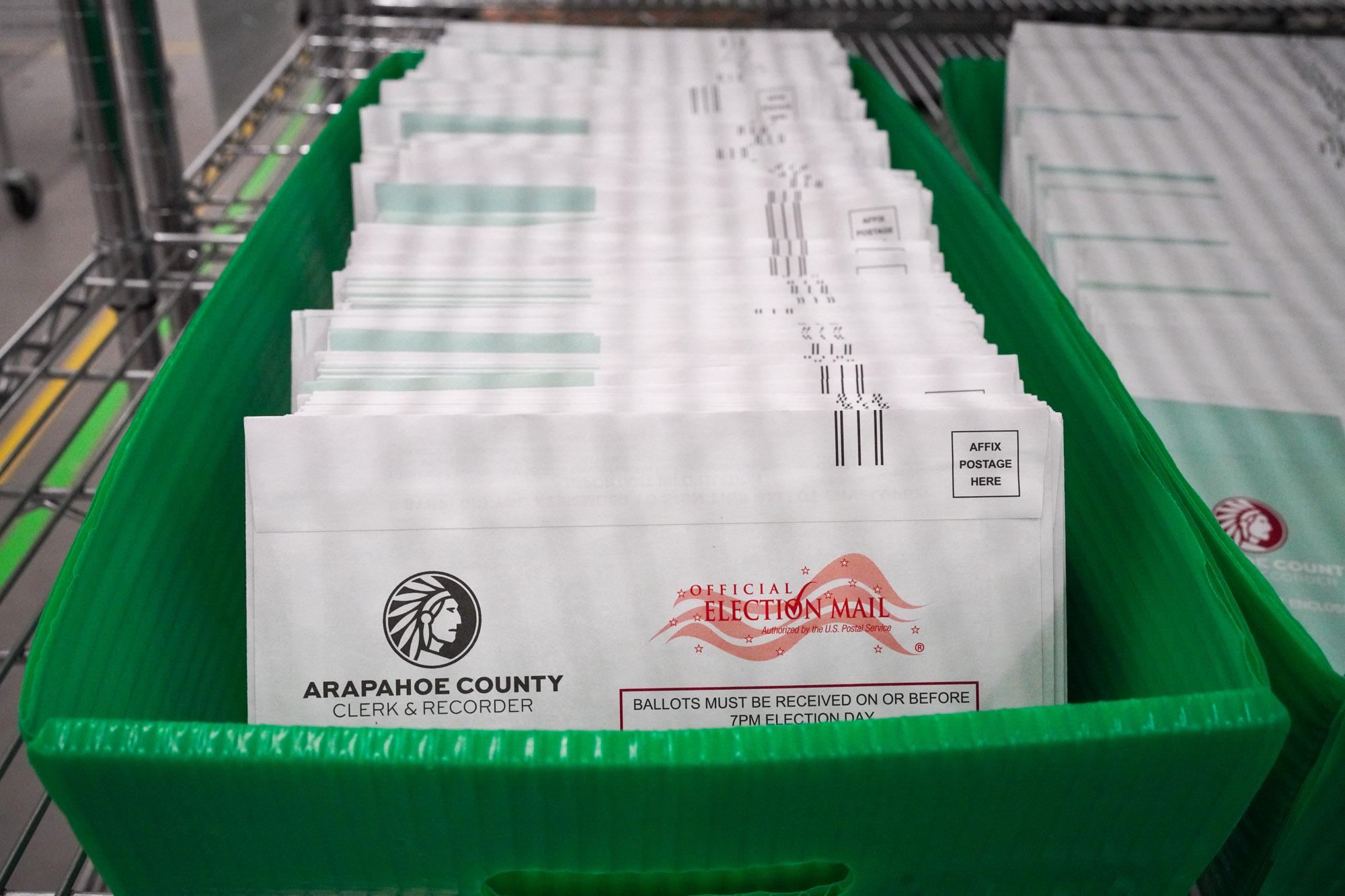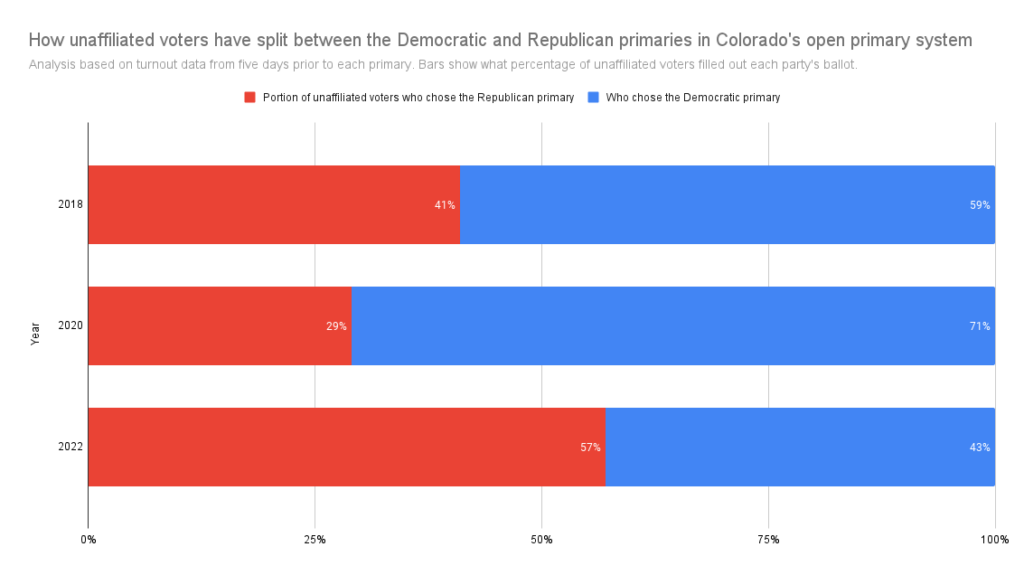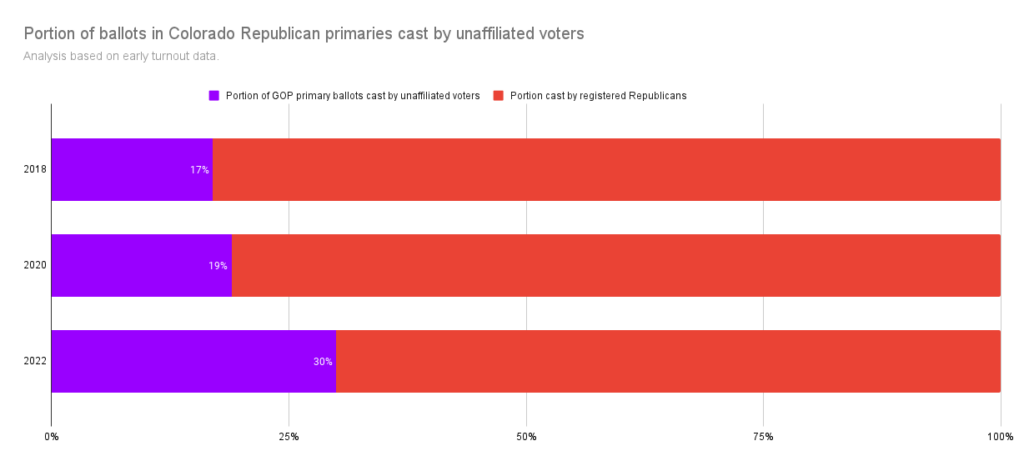
Tuesday’s primary election is in many ways a battle between the Republican Party’s moderates and its growing right wing in Colorado. But the fight won’t be decided by just the party’s usual voters.
Early turnout data shows that unaffiliated voters are flocking to the GOP primaries — and will affect the party’s political calculus in an especially important election year.
Among them is Raul Borrastero, 65, an unaffiliated voter in Brighton. He normally leans liberal, but on a recent Friday morning, he was heading toward a dropbox with a ballot for the Republican primary.
It was a simple choice, he said: The Republican races were more interesting this year.
“The Democrats … have mostly single options on most of their (races,) whereas Republicans have several multiple-choice (races),” Borrastero said. “So, I studied a little bit of the Republican side, and that's what I decided to do.”
Colorado has had “semi open” primaries since 2018, allowing unaffiliated voters to choose to participate in either party’s contest.
In the first two elections under the system, most unaffiliated voters chose to fill out the Democratic ballot. While there were high profile Democratic primaries in both 2018 and 2020, it was also a sign that the state’s unaffiliated voters skew liberal. And, indeed, Democrats went on to win those elections by large margins.
This year, the trend is reversing. About 57 percent of unaffiliated voters are choosing the Republican primary ballot, according to early turnout data.

David Flaherty, a Colorado-based pollster who focuses on ballot initiatives, agreed the Republican primaries are attracting voters because they’re so hotly contested.
“Unaffiliateds that are paying attention to politics and have an interest in it will make their decision. Even if they don’t lean Republican, they’re going to perhaps make a choice (in the Republican primary),” said Flaherty, whose firm used to focus on Republican candidates.
This year, the GOP contests have stark contrasts in several statewide races — pitting election deniers and anti-abortion hardliners against somewhat more moderate candidates. Unaffiliated voters also may be participating because they’re more interested in the Republican message this year. Meanwhile, the Democrats have no statewide contests to attract voters’ attention.
Another crossover voter is Andy McNulty, a civil rights attorney in Denver. He cast his first-ever Republican ballot this year. He only voted in one race: secretary of state.
“I couldn't stomach the thought of Tina Peters running our electoral system in Colorado,” he said. (Peters is under indictment for allegedly breaching Mesa County’s voting hardware in search of fodder for election conspiracy theories. She is the county clerk there but has been barred by a judge from overseeing this year’s election.)
“It would be a threat to democracy in this state and a threat to our very system of government for her to be in charge,” McNulty said.
The surge of unaffiliated voters may benefit some centrist candidates, Flaherty said.
“It would be foolish to make that assumption that these votes are going in a certain candidate’s bucket,” he said. But well-funded candidates like Joe O’Dea could be spending heavily to pull in moderate unaffiliated voters in these final days, he theorized.
Unaffiliated voters have made up the largest group of voters in Colorado for a number of years now.
As of Monday, unaffiliated voters have cast more than 30 percent of the ballots returned in the Republican primary electorate this year — compared to 20 percent or less in comparable data for past years. The flip side of this is that unaffiliated voters are making up a smaller-than-usual portion of the Democratic primary electorate this year.

Unaffiliated voters also may play a more pronounced role in some specific races this year. For example, a CPR News analysis found that about 8,000 Democrats have switched to unaffiliated status in the 3rd Congressional District; many have said they plan to vote against Republican Congresswoman Lauren Boebert in her primary. (An earlier analysis found a smaller number of switchers.)
A similar strategy helped to defeat Republican Rep. Madison Cawthorn in North Carolina, according to an analysis published in The Washington Post.
This year, in interviews and online, numerous unaffiliated voters told CPR News that they were planning to vote for the more moderate Republican candidates. Still, Flaherty cautioned that unaffiliated voters have many different motivations. Some are true “swing” voters, but many are deeply liberal or conservative. A few may even cast “spoiler” votes — helping out a far-right candidate whom they think will be easier for Democrats to beat in the general election.
Colorado’s open primary system was approved by voters in 2016 and first implemented in 2018. It was supported in large part by business groups, who hoped it would result in more moderate candidates who could reduce political gridlock.








